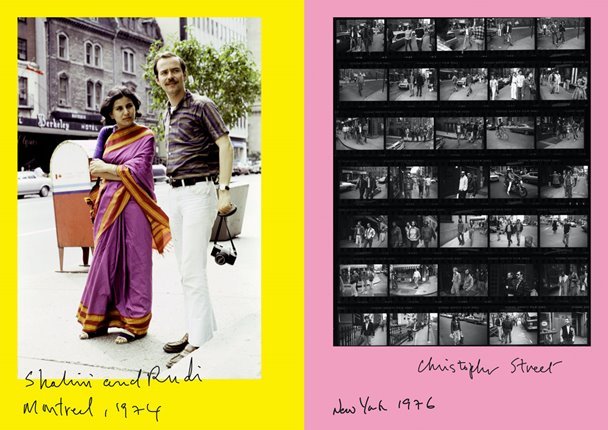BOOK REVIEW:
On Sunil Gupta’s “From Here to Eternity”
By Rafael Soldi | Published September 8, 2022 in Strange Fire Collective

Courtesy of the artist and Autograph ABP
On the cover we see a young Gupta pointing a camera directly at the viewer—one eye covered by the viewfinder and the other open and defiant gazing out at us. But one quickly realizes it’s a self portrait in a mirror, the gaze is also on himself. Gupta’s practice is similarly split—on one end he looks at his own life with a sensual, emotional, and empathetic gaze, and on the other he looks at the world through a lens of political activism and defiance. "What does it mean to be a gay Indian man?,” Gupta asks, “ This is the question that follows me around everywhere I go and is still ever present in my work." For nearly five decades, Gupta's lens has examined issues of family, race, migration and the complexities and taboos of sexuality and homosexual life.
As the title suggests, From Here to Eternity is about time. The 1974 Gupta on the front cover is directly opposite the 2020 self-portrait on the back cover, which pictures the artist’s torso with medical devices attached to it, captioned “Having heart rate monitor installed.” It’s clear from the start that with this document, Gupta invites us to participate in his personal, political, and artistic evolution. Inside one finds colorful pages in bright red, pink, orange, yellow, and green peppered with snapshots, postcards, letters, posters, and news clippings collected during his long career in photography and activism. Each item is captioned in the artist’s handwriting in an informal and narrative way. Everything is dated, and the story begins in 1974 with a photograph of an early gay liberation protest in Montreal. Gupta’s work “has been instrumental in raising awareness around the political realities concerning the fight for international gay rights and of making visible the tensions between tradition and modernity, public and private, the body and body politics.”

Courtesy of the artist and Autograph ABP
“At the soul of Gupta’s practice,” Sealy notes, “...is the idea of family, real or imagined.” The fragmented ephemera charts Gupta’s deep and powerful relationships in moments of protest, in the black arts movement in Britain, in queer communities in India, and with his own family. What emerges is a moving portrait of the artist’s struggles, achievements, and a life lived through the complex politics of social change.
In an early page we see a contact sheet of Gupta’s now-famous Christopher Street pictures from 1976. A few pages later, a 1980 self portrait opposite a blown-up reproduction of a TIME magazine cover that reads “How Gay Is Gay?”. Curiously, he captions all self portraits as “selfies,” a contemporary term that would not have been in use at the time most of these images were made. I enjoyed this verbiage because it clues us into the fact that these are contemporary captions, in a way they act as a memoir and first-hand recollection of life as he remembers it in this moment. A snapshot picturing young men dancing reads “Private gay parties for men of color and some white friends and lovers,” while a 1983 portrait of him as a young student at the RCA’s photography department with Emily Anderson reads “...2 out 7 students being queer then was a good ratio. We’ve been close friends ever since.” As the book progresses we continue to see his family, friendships, and a range of documents, exhibition announcements, and correspondence that track Gupta’s growing recognition and activism. For example, a 1986 flier promoting Same Difference, an early LGBTQ exhibition organized by Gupta and Jean Fraser at Camerawork.


